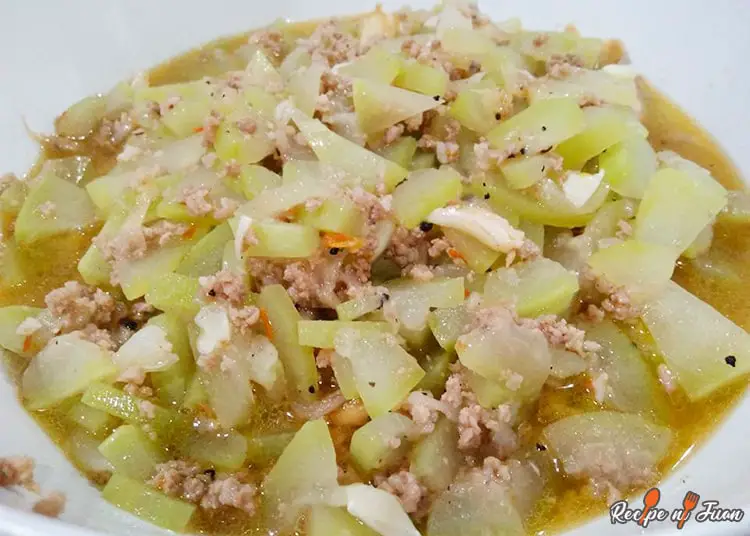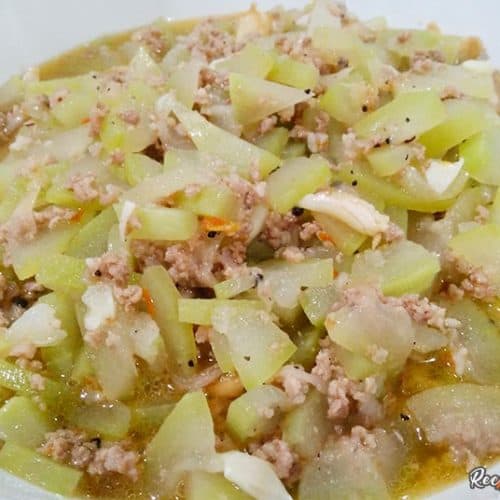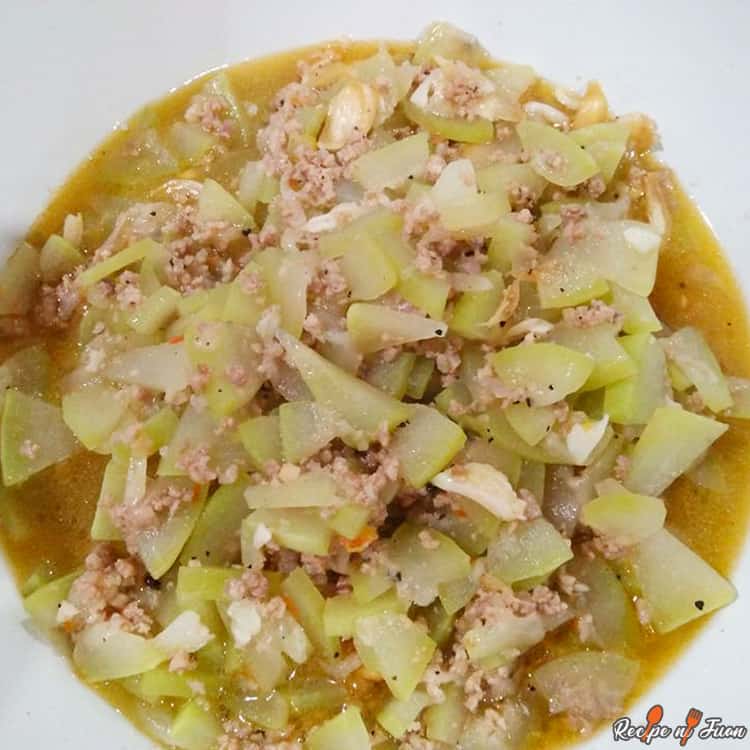Pork & sauteed upo gourd: A simple but tasty ginisang upo recipe
This ginisang upo recipe or sauteed bottle gourd is a simple dish that everyone can cook.
Anything ginisa (or sauteed) has a place in the Filipino lifestyle, as sometimes, people just don’t have the means or the time to make grandiose meals. And this ginisang upo recipe provides people with a meal fit for both lunch and dinner!
Let’s get cooking so you can have it on the table before you know it!

A humble but flexible dish, ginisang upo can be cooked with a variety of ingredients, depending on whatever’s handily available to the cook. Aside from the gourd, ginisang upo typically includes ground meat, unskinned shrimp, and tomatoes.
This recipe is really flexible, as the humble-tasting upo actually ups the flavor of whatever other ingredients you include with it. It also provides the necessary health benefits and crunch to the meal!
It’s easy to make and is budget-friendly too, so this should always be included in your to-cook list.

Also check out our delicious ginisang baguio recipe

Check out our new cookbook
Bitemybun's family recipes with complete meal planner and recipe guide.
Try it out for free with Kindle Unlimited:
Read for freeIn this post we'll cover:
How to make ginisang upo at home

Ginisang upo recipe
Ingredients
- ¼ lb pork steak cut into small cubes
- 1 medium upo (gourd)
- 1 large tomato sliced
- 1 medium onion sliced
- 2 cloves garlic minced
- 1 cup water
- 1 tsp alamang
- Cooking oil
- Ground pepper
Instructions
- In a pan, saute garlic, onion, and tomatoes in cooking oil.
- Add the pork. Cook until the meat turns light brown.
- Then add the alamang and cook for few minutes.
- Add the water and simmer until the pork is tender.
- Add the upo and season with ground pepper.
- Simmer for few minutes. Make sure not to overcook the upo.
- Serve hot with steamed rice.
Nutrition
Check out this video by YouTube user Panlasang Pinoy on how to make ginisang upo:
In all, this ginisang upo recipe is a simple but tasty dish that can always be made fancy with a little imagination.

Also check out this atsarang labaons or Filipino pickled radish recipe
Cooking tips
Ginisang upo is one of the easiest recipes to make in Filipino cuisine. However, you still need to keep a few little things in mind to cook the dish to perfection.
Cut the gourd and pork uniformly
Cutting the gourd and pork in uniform sizes ensures that the dish is cooked evenly.
If you don’t do this, there’s a good chance that some chunks will get overcooked while others will remain undercooked, affecting both the taste and texture of the dish. Or in simpler words, it’ll turn your dish into a mess!
Be careful with water
Vegetables like gourds are filled with ample water that’s released during cooking. So be a bit careful with how much water you put in the pan, perhaps half of what you usually use.
Otherwise, the dish will get quite soggy, which ruins the fun and flavor of ginisang upo. But if you want, more broth, you can always add water and boullion to the mix as well.
Don’t cook the dish fully
Yup, I know this sounds a little weird. But hear me out!
Vegetables like gourds cook in the residual heat even after being taken off the stove. Hence, leaving the gourd a little firmer will ensure that your dish has the perfect texture, with just the right amount of softness when served.
Be generous with the spices
Upo gourd has a very mild and delicate flavor that, when combined with an extravagant amount of water, tends to neutralize any added spices. So be generous with the spices as you cook the dish.
Also, don’t forget to season it with ground pepper. It helps intensify the flavor!
Make something else with the leftovers
If you have some shrimp left over, you can always make a ginataang puso ng saging like this, which is dried shrimp & coconut.
However, if you want to use a can of tomato sauce-based sardines, then ginisang upo is the perfect recipe for it. To further stretch this recipe, you can also use misua or sotanghon.
Substitutes and variations for ginisang upo
While the simplicity of ginisang upo makes it an excellent, light-flavored dish, it also makes room for a lot of experimentation with different ingredients. Here are some exciting variations of ginisang upo you should try or may even prefer over the original recipe!
Substitute the bottle gourd
If you don’t have any bottle gourd, you can always use sayote as a substitute. Or for the brave, you can use papaya.
Ginisang upo with ground pork and shrimp
This recipe is a classic take on the basic gourd and pork recipe, having shrimp and parsley as extra ingredients.
The overall cooking method of this variant is the same as the basic recipe, and you can serve it at both lunch and dinner. The extra punch of shrimp and parsley adds a certain depth to ginisang upo, which makes it from just yummy to super yummy!
Ginisang upo with spinach
Don’t have pork or protein, or are you just an avid vegetarian? Then you need to try out ginisang upo with spinach!
It’s a purely vegetarian take on the original recipe that replaces the pork with spinach. Though the flavor is slightly different from the original recipe, the taste is still great…just milder.
As for the preparation method, it’s the same.
Ginisang upo with ground beef
Do you know what’s great about ground beef? It fits anywhere you put it, and the ginisang recipe is no exception.
Try replacing pork with ground beef and see the dish take a new, more fulfilling, and beefy flavor that tastes like utmost perfection!
It’s also one of the most common variants of ginisang upo and is even cooked in South Asian cuisines with a few tweaks.
How to serve and eat
Ginisang upo is rarely eaten on its own and is often served with other dishes to add flavor and texture.
Most commonly, it’s eaten with steamed rice, as the dish tends to get oily from the meat, sardines, or oil used for sauteing. It’s also recommended that you serve this dish with atsara (pickled shredded papaya and carrots) to counter the oil.
Usually, the dish is accompanied by something spicy and crunchy, like grilled meat or fried fish.
All the above add up well and make an exciting combination of flavors that works great for lunch and dinner!
Similar dishes
I say this repeatedly, and I’ll say this again, I love the creativity of Filipino cuisine, even in all its simplicity. Whether a dish is vegan or non-vegan, there’s no way it’s not going to be delicious.
That said, the following are some other dishes similar to ginisang upo that you should try.
Ginisang patola
Ginisang patola is a Filipino dish with the same ingredients as a typical ginisang upo but with one primary replacement: that’s using sponge gourd instead of “patola”, or luffa instead of upo or bottle gourd.
However, it has the same taste as ginisang upo, with a tinge of sweetness that makes it both unique and flavorful!
Ginisang ampalaya
As the name suggests, this dish uses ampalaya instead of gourd. The preparation method, as expected, is the same.
However, the flavor is entirely different, with the ampalaya chunks giving the dish a set of subtly savory and bitter notes, but not in a bad way.
Usually, the ampalaya cuts are first soaked in saltwater to make the bitterness milder. It can get overwhelming for some people if cooked in its raw form.
Upo guisado omelet
Well, this one’s a little unique! Still, it’s a perfect recipe to start your day or kill hunger with something delicious that doesn’t require much effort to make.
Admittedly, the cooking method of the dish is quite complex compared to the common omelet. However, what you get is worth every second spent preparing the dish!
FAQs
Do you remove seeds of upo?
Yes, it’s necessary to remove the seeds and spongy interior of the upo. Otherwise, it’ll get mushy during cooking.
Is upo healthy?
Upo is an extremely healthy vegetable that’s filled with vitamins and minerals. Plus, it also helps with weight loss due to its low calorie count, and fights cancer cells developing in the body.
Is upo good for people with diabetes?
In short, yes! Upo contains a lot of water and fiber with negligible glucose or sugar.
So it’s not only great for diabetics, but also excellent for avoiding diabetes in the first place.
Can I eat ginisang daily?
Well, if you like it, then why not?
But I’d highly recommend trying different varieties of the dish. The same meal every day can bore you, even if it’s for nutritional value.
Give this upo dish a try
For those who don’t have the time to whip up fancy dishes, ginisang upo is an easy and delicious recipe that takes 20 to 30 minutes max to prepare. And even then, any vegetable dish hardly matches the taste and flavor it brings to the table!
In this article, I tried to cover every aspect of the dish, along with a fantastic recipe you can try right now!
I hope this piece has been helpful and informative throughout. So get your ingredients together, and go to your kitchen right now!
Until then, I’ll come up with another awesome recipe for you. Happy cooking!
Also read: Ampalaya with alamang recipe
To find out more about ginisang upo, read this article.
Check out our new cookbook
Bitemybun's family recipes with complete meal planner and recipe guide.
Try it out for free with Kindle Unlimited:
Read for freeJoost Nusselder, the founder of Bite My Bun is a content marketer, dad and loves trying out new food with Japanese food at the heart of his passion, and together with his team he's been creating in-depth blog articles since 2016 to help loyal readers with recipes and cooking tips.
